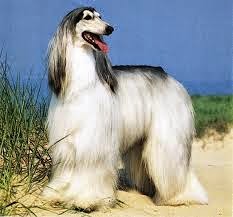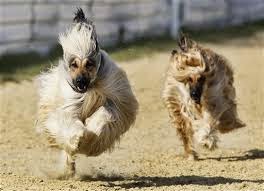Dogs


- Golden Retriever
Brief HistoryOriginating in the Scottish Highlands in the late 1800s, the Golden Retriever was developed by Lord Tweedmouth, by crossing the original yellow Flat-Coated Retriever with the now extinct Tweed Water Spaniel. He later crossed in the Bloodhound,...
- English Cocker Spaniel
HistoryThe English Cocker Spaniel is one of the oldest spaniels known. Originally known as a general spaniel-type dog that was imported into England centuries ago, the dogs were divided into seven different spaniel breeds: the English Springer, the Cocker...
- American Cocker Spaniel
HistoryThe Cocker Spaniel dates back as far as the 14th century. The breed originated from the English Cocker Spaniels which were brought to the United States. The Spaniels were bred down in size and given the name American Cocker Spaniels,...
- The Pharaoh Hound
Brief HistoryThe Pharaoh Hound is one of the oldest domesticated dog breeds in the world. The breed is estimated to have originated around 4000 to 3000 BC. The breed's exact origin is unknown, but one belief is it began in ancient Egypt. Numerous...
- The Basset Hound
HistoryThe Basset Hound is an old breed which is a direct descendent of the Bloodhound and has a nose that is almost as outstanding. Some sources suggest the Basset Hound may have originated from genetic dwarf dogs that were born in litters...
Dogs
Afghan Hound Breed

History
This is a very elegant, ancient dog breed, native to Sinai, and mentioned several times in Egyptian papyruses as well as pictured in the caves of northern Afghanistan more than 4000 years ago. The breed was kept pure for centuries, and its exportation was always prohibited. It therefore only reached Europe as contraband early in the 1900s. An extremely fast and agile runner, the Afghan is a sighthound, which means it hunts by sight. It was used as a shepherd and as a hunter of many types of game including deer, wild goats, snow leopards and wolves. They were also used by shepherds as herders and watchdogs. Their thick coat protects against temperature extremes. In Europe and America they have become a luxurious pet and show dog because of their aristocratic beauty. Some of the Afghan's talents are hunting, sighting, tracking, herding, watchdog, racing and lure coursing.
Appearance
The Afghan Hound is considered an aristocratic sighthound. Tall and slender with a long, narrow, refined head, silky topknot and powerful jaws, the back part of the head and skull are quite prominent. The muzzle is slightly convex and the nose is black. The Afghan has little or no stop, which is the transition area from backskull to muzzle. The teeth should meet in a level or scissors bite. The dark eyes are almond shaped. The ears lie flat to the head. The neck is long and strong. The height at the withers should be almost level and the abdomen well tucked up. The hipbones are quite prominent. The front legs are strong and straight and the feet are large and covered with long hair. The tail has a curl or ring at the tip, but is not carried over the back. The long, rich, silky coat is most often the color of sand with a darker face and ear fringes, though all colors are permitted. White markings, however, are discouraged.

Temperament
Courageous, dignified, spirited, very sweet, loyal, affectionate and sensitive, with a low dominance level, the Afghan can be somewhat aloof, but socialize well. They must be trained kindly yet in a calm and firm manner. The Afghan has been described as "a king of dogs"—noble, majestic and elegant. They tend to be suspicious of those they do not know, but not hostile. Although tough, they will pine if they are deprived of proper gentle leadership. They will do best with older, considerate children who understand how to be a gentle pack leader. Amenable to training and discipline, they can be disobedient if an owner does not give the dog clear guidelines and consistency with what is expected of their dog. This breed can be difficult to housebreak. It can also be timid and high-strung if it does not receive enough mental and physical exercise.
Size
Height: Males 27 - 29 inches (68.58 - 73.66 cm); slightly less for females.Weight: 50 – 64 lb. (22 – 34 kg). Average life span of this breed is about 14 Years.
Grooming
The long, thick coat demands a great deal of attention. Bathe the dog when necessary. Do not brush in between baths in order to keep coat long and shiny. Brushing a dry coat will damage the coat and even make it more easily matted. Weekly baths are not as important if your Afghan is a pet and will not be shown, but doing so will make the coat less matted and will save you time in the end. Many wear snoods indoors to protect their ears from food bowls. Some owners like to use a special air-cushioned brush called a pinbrush. This breed is an average shedder.
The Afghan Hound needs to be taken on a long daily walk or jog. While out on the walk the dog must be made to heel beside or behind the person holding the lead, as in a dog's mind the leader leads the way, and that leader needs to be the human. Dogs that do not get to go on daily walks are more likely to display behavior problems. Teach them to enter and exit door and gateways after the humans. They will also enjoy running free in an open, fenced, safe area.
The Afghan Hound is not recommended for apartment life. They are relatively inactive indoors and do best with acreage. This breed can live in or outdoors, although it would be happier sleeping indoors.
- Golden Retriever
Brief HistoryOriginating in the Scottish Highlands in the late 1800s, the Golden Retriever was developed by Lord Tweedmouth, by crossing the original yellow Flat-Coated Retriever with the now extinct Tweed Water Spaniel. He later crossed in the Bloodhound,...
- English Cocker Spaniel
HistoryThe English Cocker Spaniel is one of the oldest spaniels known. Originally known as a general spaniel-type dog that was imported into England centuries ago, the dogs were divided into seven different spaniel breeds: the English Springer, the Cocker...
- American Cocker Spaniel
HistoryThe Cocker Spaniel dates back as far as the 14th century. The breed originated from the English Cocker Spaniels which were brought to the United States. The Spaniels were bred down in size and given the name American Cocker Spaniels,...
- The Pharaoh Hound
Brief HistoryThe Pharaoh Hound is one of the oldest domesticated dog breeds in the world. The breed is estimated to have originated around 4000 to 3000 BC. The breed's exact origin is unknown, but one belief is it began in ancient Egypt. Numerous...
- The Basset Hound
HistoryThe Basset Hound is an old breed which is a direct descendent of the Bloodhound and has a nose that is almost as outstanding. Some sources suggest the Basset Hound may have originated from genetic dwarf dogs that were born in litters...
